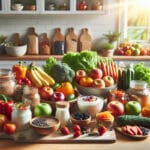The Rise of Regenerative Organic Farming and Its Impact on Sustainability and Consumer Health in 2025
In 2025, regenerative organic farming has become one of the most influential movements in the global food system. It’s more than just a trend — it’s a transformation in how we grow, source, and consume food. As consumers demand cleaner labels, ethical sourcing, and environmental accountability, regenerative organic practices are redefining what “organic” truly means.
Supported by initiatives like the EU Farm to Fork strategy, this farming approach goes beyond sustainability to actively restore ecosystems, improve soil health, and enhance biodiversity. According to the FiBL Organic World 2025 report, regenerative organic systems are now recognized as key to achieving both climate resilience and food security.
What Is Regenerative Organic Farming?
Regenerative organic farming is an advanced form of organic agriculture that focuses on regenerating, rather than depleting, natural resources. It integrates soil restoration, crop diversity, animal welfare, and fair labor practices into one holistic system.
| Core Principle | Regenerative Practice | Impact |
|---|---|---|
| Soil Health | Composting, cover crops, reduced tillage | Improves microbial life and carbon sequestration |
| Biodiversity | Crop rotation, agroforestry | Enhances resilience and pollination |
| Animal Welfare | Pasture-based systems | Supports ethical and sustainable livestock management |
| Fairness | Fair trade and equitable labor | Strengthens rural communities and fair wages |
Why Regenerative Organic Farming Matters in 2025
Consumers are increasingly aware that sustainability isn’t enough. The goal now is regeneration — restoring what has been lost. This shift is visible across the global organic food market, where transparency, traceability, and ethical production are top priorities.
Environmental Benefits
- Carbon Sequestration: Healthy soils act as carbon sinks, helping to mitigate climate change.
- Water Retention: Regenerative practices improve soil structure, reducing erosion and water waste.
- Biodiversity Restoration: Diverse ecosystems support pollinators, wildlife, and natural pest control.
Health and Nutrition Benefits
Studies cited by FiBL show that organic foods grown in regenerative systems often contain higher levels of antioxidants and essential nutrients. Consumers also benefit from reduced exposure to synthetic pesticides and fertilizers, aligning with the clean label movement.
Organic Food Sustainability and Market Growth
The European organic food market continues to expand, driven by consumer trust and policy support. Regenerative organic farming is at the core of this growth, offering measurable sustainability outcomes and a strong marketing advantage for brands.
According to Kadence International, consumers in 2025 are choosing brands that demonstrate authentic environmental responsibility. This has led to a surge in clean label organic products and plant-based organic trends across Europe and North America.
Key Market Trends for 2025
- Increased demand for plant-based and organic product innovations
- Expansion of organic food procurement in public institutions
- Rising consumer preference for local and traceable supply chains
- Integration of regenerative principles into corporate sustainability goals
From Farm to Fork: Policy and Regulation
The EU Farm to Fork strategy aims to make food systems fair, healthy, and environmentally friendly. It supports regenerative organic farming through incentives for soil restoration, biodiversity protection, and reduced chemical inputs. These policies are helping Europe lead the global transition toward sustainable food systems.
How Regenerative Organic Farming Improves Soil Biodiversity
Healthy soil is the foundation of life. Regenerative organic farming enhances soil biodiversity through natural nutrient cycles and microbial activity. Practices like composting, cover cropping, and rotational grazing increase soil organic matter, which boosts fertility and water retention.
As highlighted in the Biofach 2024 report, the future of food depends on how we treat our soil. Regenerative methods not only sustain production but also rebuild ecosystems that industrial agriculture has degraded.
Clean Label Organic Products and Consumer Trust
Transparency is now a key purchasing factor. Consumers want to know where their food comes from and how it’s produced. Regenerative organic certification provides that assurance, combining organic standards with measurable ecological impact.
Brands adopting regenerative practices are gaining market share by aligning with the clean label movement — products free from artificial additives, GMOs, and synthetic chemicals. This shift supports both consumer health and brand loyalty.
Technology and Innovation in Regenerative Organic Farming
Digital tools are helping farmers measure soil health, track carbon levels, and optimize resource use. Apps like Food Scan Genius empower consumers to scan products and instantly see ingredient origins, allergen information, and sustainability ratings.
“I started using Food Scan Genius to check the sustainability of my favorite organic snacks. It’s amazing how transparent brands have become — I can see which ones follow regenerative practices!” — Julia, conscious consumer
Tools like these promote ingredient transparency and help bridge the gap between producers and consumers, supporting the broader goal of sustainable food systems.
Challenges and Opportunities Ahead
While regenerative organic farming offers immense benefits, it also faces challenges such as certification complexity, higher initial costs, and the need for farmer education. However, as awareness grows and policy support strengthens, these barriers are gradually being overcome.
Market data from Kadence International suggests that regenerative organic products will become mainstream by 2030, driven by consumer demand for ethical and climate-positive food.
Global and Regional Perspectives
Europe leads the regenerative organic movement, with strong policy backing and consumer engagement. North America follows closely, with major retailers promoting regenerative-certified products. Emerging markets in Asia and Latin America are also adopting regenerative principles to combat soil degradation and climate risks.
According to Biofach 2024, global collaboration and knowledge exchange are essential for scaling regenerative practices. Education, technology, and transparent labeling will continue to drive adoption worldwide.
Why Regenerative Organic Farming Matters for Everyone
This movement isn’t just for farmers or environmentalists — it affects everyone who eats. By supporting regenerative organic products, consumers contribute to healthier soils, cleaner water, and a more resilient planet. Businesses that adopt regenerative sourcing gain trust, loyalty, and long-term sustainability advantages.
FAQ: Regenerative Organic Farming in 2025
1. What is the difference between organic and regenerative organic farming?
Organic farming avoids synthetic chemicals, while regenerative organic farming goes further by restoring soil health, increasing biodiversity, and improving ecosystem resilience.
2. How does regenerative organic farming help fight climate change?
It enhances soil carbon sequestration, reducing greenhouse gases and improving climate resilience.
3. Are regenerative organic foods healthier?
Yes. They often contain more nutrients and fewer chemical residues, supporting overall wellness and clean eating.
4. What role does the EU Farm to Fork strategy play?
It promotes sustainable agriculture by incentivizing regenerative practices, reducing chemical inputs, and improving food transparency.
5. How can consumers identify regenerative organic products?
Look for certifications or use apps like Food Scan Genius to verify sustainability and ingredient transparency.
6. What are the main challenges for regenerative organic farming?
Certification costs, farmer training, and scaling production remain key challenges, but policy support and consumer demand are helping overcome them.
Final Takeaway
Regenerative organic farming represents the next evolution of sustainable food systems. It restores ecosystems, supports farmer livelihoods, and delivers healthier food for consumers. As the world moves toward 2025 and beyond, understanding what’s behind our food labels — and choosing regenerative options — is one of the most powerful ways to support both personal health and planetary well-being.
For those who want to make informed choices, the Food Scan Genius app offers a simple way to explore ingredient transparency and sustainability scores before buying. Together, informed consumers and regenerative farmers are shaping a cleaner, healthier, and more resilient food future.





